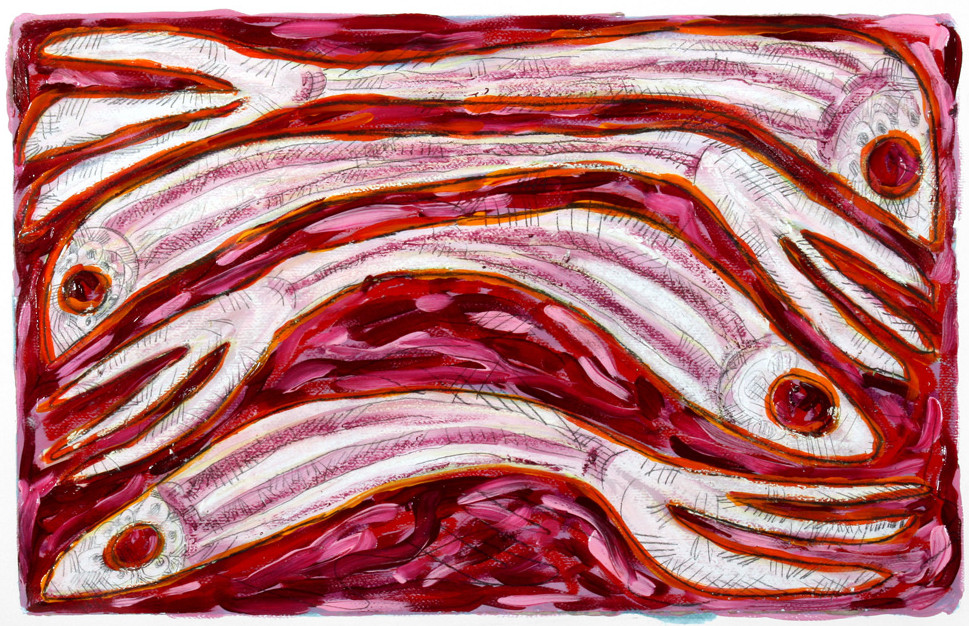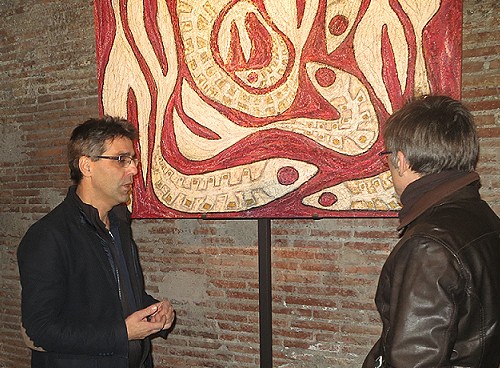
Can you explain who you are and how you approached the artistic creation on the theme of the sea? We would like to know a bit more about the reasons for choosing the course of the exhibition inside of the Markets of Trajan, striking both for the works on display and for a way you arrange them in those places full of history. We are also curious about how you use different materials for your works and the fact that the exhibition deliberately offers more than a purely visual experience. What do you try to evoke in visitors by appealing to other senses, and what message you would like visitors to take home with them after their visit? And finally, what are your plans for the future?
OB: : It's a real joy to have known the meritorious work of Mundus maris and the people who work for its goals with great enthusiasm. The meeting with Paolo Bottoni was empathetic and certainly fruitful given the excellent review article he wrote about the exhibition. So I gladly try to answer your questions.
 My research around the icon of the "fish" dates back to 1995, when I was called upon to decorate a chapel designed by Eugene Abruzzini for UNITALSI on top of a reception facility at a Lourdes hospital, one of the liturgical spaces overlooking the Gave River, right next to the cave of miracles.
My research around the icon of the "fish" dates back to 1995, when I was called upon to decorate a chapel designed by Eugene Abruzzini for UNITALSI on top of a reception facility at a Lourdes hospital, one of the liturgical spaces overlooking the Gave River, right next to the cave of miracles.
I was asked to represent the water as a symbol of hope, life and rebirth, and I have created a large cross formed only from fish, fish which I then carved into the altar, the portal and the ciborium. I also recorded the fish on the spherical tabernacle supported by three flying angels.
It was very strong experience working in an environment which is so mystical and so close to the suffering of the people. I was present at the inauguration of the chapel by Enzo Biagi, who came from Sicily by the white train full of seriously ill children who left their thoughts written at the foot of the cross ... I read some of them, but then could not continue barely retaining my tears, I had to stop ...
After some time I was myself seriously ill, the doctors gave me a zero-chance of survival ... but thanks to God I am here... that August after surgery, once again woken up in a hospital bed in Paris I began or rather continued what I had started in Lourdes... create fish.
 Then I discovered the importance and richness of this symbol, its ability to evoke the element which is life itself: water. The "fish", since the dawn of humanity, has been the bearer of messages, a messenger between the human and the divine, revealing a silent depth of the soul, capable of going beyond the unknown. In the Bible, Tobias caught a fish, he eats its flesh, then he preserves other parts to dispell a curse that affects his future wife and to restore eye sight to his old father.
Then I discovered the importance and richness of this symbol, its ability to evoke the element which is life itself: water. The "fish", since the dawn of humanity, has been the bearer of messages, a messenger between the human and the divine, revealing a silent depth of the soul, capable of going beyond the unknown. In the Bible, Tobias caught a fish, he eats its flesh, then he preserves other parts to dispell a curse that affects his future wife and to restore eye sight to his old father.
The fish has been revered by the Babylonians, Egyptians and Romans, sometimes symbolising the divine and sometimes the human being as the bearer of prosperity and abundance. With my solo exhibition "Mediterraneum" I wanted to tell the importance of fish in the development of Mediterranean civilisation as food of salvation, spiritual as well as protein food widely eaten in the ancient world. And the spaces of the Markets of Trajan make this path even more impressive through the passage from one taberna to another.
 I wanted to create a complete sensory journey: at the entrance of every taberna a bowl with Mediterranean fragrance greets the visitor, the soundtrack by maestro Giancarlo Russo evokes the sounds of the sea with whale songs, the lights of Marco Maione make the scuptures appear from the shadows of the archaeological sites. The visitor is invited also to touch the rough and uneven surfaces of large mosaics created specifically for this exhibition, a tribute to the Roman mosaic. Then I set up the last taberna as a sort of fish counter, citing a Mediterranean market with pottery and painted bowls.
I wanted to create a complete sensory journey: at the entrance of every taberna a bowl with Mediterranean fragrance greets the visitor, the soundtrack by maestro Giancarlo Russo evokes the sounds of the sea with whale songs, the lights of Marco Maione make the scuptures appear from the shadows of the archaeological sites. The visitor is invited also to touch the rough and uneven surfaces of large mosaics created specifically for this exhibition, a tribute to the Roman mosaic. Then I set up the last taberna as a sort of fish counter, citing a Mediterranean market with pottery and painted bowls.
Undoubtedly the exhibition should be a time for reflection on how much we are linked to the water, and how all living things depend on the preservation of this immense good that is here on earth, only and only here.
Many people ask me if I continue my research still focused on this single issue. I reply that even if the fish is silent, it is still speaking to me.
Notes to the text:
Lourdes is a village in France, located in the foothills of the Pyrenees Mountains that separate it from Spain. In 1858, a young peasant girl, Bernadette Soubirous, had mystic visions in a cave, which the Catholic Church recognised as higher manifestations. It immediately became a place of pilgrimage to the Lourdes cave, which is visited nowadays by about 6 million pilgrims every year.
Enzo Biagi (1920-2007) was one of the best-known and respected Italian journalists of the twentieth century.
The ciborium is a goblet in which the holy wafers are preserved which are consumed in the ritual of the Catholic Mass. At the end of the ritual it is place in the tabernacle, a special container fixed to the structure of the altar. It should be noted that the Latin term tabernaculum is a diminutive form of the taberna met earlier in the article, the very venue of the exhibition in the tabernae of an ancient Roman market.
 The Latin word taberna was not only used for what we would nowadays call a tavern, a place for consumption of food and wine, but also for the place to exercise the trade or craft. The markets built in the second century of our era by Emperor Trajan in Rome were dedicated mainly to trade across the wide area of the Mediterranean Sea, simply called mare nostrum (our sea) by that civilisation, as it was the main way of communication and exchange, commercially, culturally and socially.
The Latin word taberna was not only used for what we would nowadays call a tavern, a place for consumption of food and wine, but also for the place to exercise the trade or craft. The markets built in the second century of our era by Emperor Trajan in Rome were dedicated mainly to trade across the wide area of the Mediterranean Sea, simply called mare nostrum (our sea) by that civilisation, as it was the main way of communication and exchange, commercially, culturally and socially.
The Roman Emperor Marcus Ulpius Trajan was born in Italica (near modern Seville in Spain) in 53 of our era and died at Selinus (modern Gazipaşa in Turkey) in 117. The arc of his life shows that the Mediterranean has been the main instrument of union of the peoples in the ancient world.








